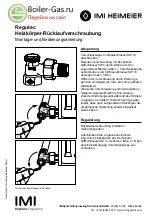
36
5600 332 v1.3
Vitodens 100-W, WB1B Installation & Service
Installation Examples
Connections
General
The schematics on the following pages are to be seen as
guidelines only. They further do not display all system
varieties, safety devices, or concepts possible. Specific
system layouts may be further discussed with the local
Viessmann sales representative office.
Clearances
A minimum of 2” (51 mm) circumferential clearance from
non-insulated hot water pipes to combustible construction
must be maintained. In cases where the pipes are insulated
with pipe insulation of appropriate and sufficient thickness
and insulation values, the above clearance may be
reduced to 0” (refer to local gas codes).
Model WB1B
26
35
∆
t
Output Btu/h
83,000
108,000
30º F rise (GPM)
5.5
----
35º F rise (GPM)
4.7
6.2
40º F rise (GPM)
4.2
5.4
Pressure drop (primary circuit) of Vitodens 100-W
The Vitodens 100-W is designed only for closed loop,
forced circulation hot water heating systems.
Heating circuit pumps
Recommended heating pumps with Vitodens 100-W,
WB1B 26, 35.
g
Grundfos 15-58 (3-speed)
g
Taco 00R
or equivalent
Refer to the graph above for the proper waterside boiler
friction loss calculations.
Pump selection must be based on accurate system flow
and pressure drop calculations (incl. DHW sizing).
A low-loss header
must
be used when the
system
flow
rate exceeds the maximum (or minimum) flow rate of
the Vitodens 100-W boiler. An alternative method may
be used, such as primary secondary piping using closely
spaced tees.
A low-loss header offers additional benefits not provided
by a pair of closely spaced tees. Viessmann strongly
recommends and prefers the use of a low-loss header
over closely spaced tees.
Use standard friction loss method for pipe sizing. Observe
boiler maximum and minimum flow rate limitations.
If system flow rate exceeds boiler maximum flow rate
(as stated on page 86) or if system flow rate is unknown,
Viessmann strongly recommends the installation of a low-
loss header. See page 49 for low-loss header information
or refer to the Vitodens Venting System Installation
Instructions.
Typical system flow rates
ft. m
Pressure Drop
Flow rate
USGPM
L/h
CAUTION
For underfloor heating applications, an additional
immersion or strap-on aquastat must be installed in the
low temperature underfloor loop (downstream of the
mixing valve) to de-energize the pump and/or boiler
to prevent overheating. High water temperatures can
damage concrete slabs.
IMPORTANT
















































